Table of Contents
Ultimate Philodendron Micans Care Guide: Healthy and Happy Plant Care
Philodendron micans is a stunning houseplant that is known for its velvety, heart-shaped leaves and trailing or climbing growth habit. It is a variety of the heartleaf philodendron, which is native to the tropical regions of Mexico and the Caribbean. Philodendron micans is easy to care for and grow indoors, as long as you provide it with the right conditions and regular maintenance.
In this article, we will cover everything you need to know about philodendron micans care, from light and water requirements to pruning and propagating tips. We will also answer some frequently asked questions and explore some similar plants that you might like.
An Introduction to Philodendron Micans Care Tips
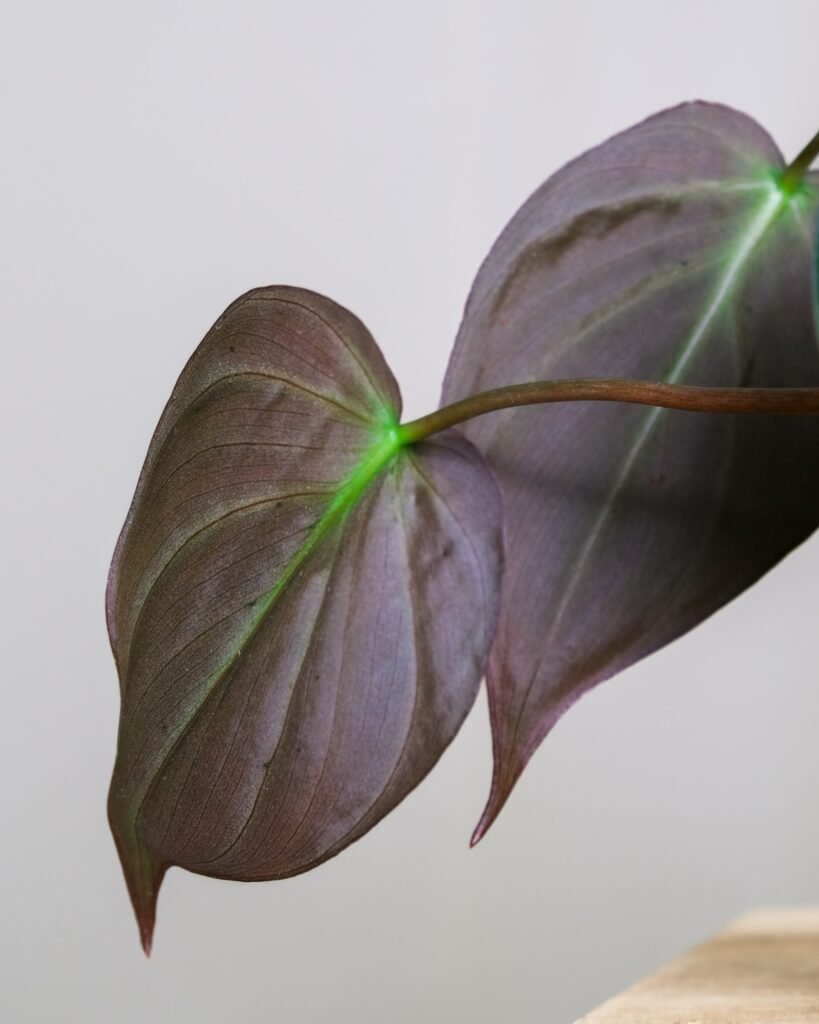
Philodendron micans is a type of philodendron plant that belongs to the Araceae family. The name “philodendron” means “love tree” in Greek, which refers to the plant’s ability to grow on other plants or surfaces. Philodendron micans is also known as velvet leaf philodendron or philodendron hederaceum var. hederaceum. It is a vining plant that can either trail down from a hanging basket or climb up a moss pole or trellis.
The leaves of philodendron micans are small, usually no more than 3 inches in width, and have a soft, velvety texture. The color of the leaves can vary from deep green to rusty hues, depending on the light exposure. The plant produces small, green-white flowers in the wild, but they are rarely seen indoors.
Characteristics of Philodendron Micans
Philodendron micans has some distinctive characteristics that make it stand out from other philodendron varieties. Here are some of them:
- The leaves are heart-shaped and have a velvety texture that feels like suede.
- The leaves change color depending on the light intensity. They can be deep green, olive green, bronze, or burgundy.
- The plant has a trailing or climbing growth habit that can reach up to 24 inches in length.
- The plant is easy to propagate from stem cuttings.
- The plant is toxic to cats and dogs, so keep it away from your furry friends.
Brief History and Origin
Philodendron micans is native to the Caribbean islands of Dominica and Tobago, where it grows as an epiphyte or epilithic plant. This means that it can grow on other plants or rocks without harming them. Philodendron micans was first described by the French botanist Charles Plumier in 1703, who named it Hedera micans. Later, it was reclassified as Philodendron hederaceum var. hederaceum by the German botanist Heinrich Schott in 1856. Philodendron micans has become popular as a houseplant in recent years, thanks to its beautiful foliage and easy care.
Why Philodendron Micans Make Great Houseplants
Philodendron micans is a great choice for anyone who wants to add some tropical flair to their home or office. Here are some reasons why:
- Philodendron micans is easy to care for and grow indoors. It can tolerate low to medium light levels and does not need frequent watering or fertilizing.
- Philodendron micans is versatile and adaptable. You can grow it in a hanging basket and let it trail down, or you can train it to climb up a moss pole or trellis and create a living wall.
- Philodendron micans is attractive and eye-catching. The velvety leaves have a unique color that changes with the light, creating a dynamic display of shades and hues.
- Philodendron micans is an air purifier. It can remove harmful toxins such as formaldehyde from the air, improving the indoor air quality and your health.
Essentials of Philodendron Micans Care
To keep your philodendron micans happy and healthy, you need to provide it with the right environment and care routine. Here are some essential aspects of philodendron micans care that you need to know:

Understanding the Light Requirements
Philodendron micans prefers medium to bright indirect light for optimal growth and coloration. Avoid direct sunlight, as it can scorch the delicate leaves and cause them to fade or turn yellow. If you have low light conditions in your home or office, you can still grow philodendron micans, but expect smaller leaves and less vibrant colors. You can also supplement the natural light with artificial light sources such as fluorescent or LED bulbs.
Proper Watering Techniques for Philodendron Micans
Watering guidelines for Philodendron Micans:
| Watering Guidelines for Philodendron Micans | How to Water | When to Water |
|---|---|---|
| 1. Check Soil Moisture | Insert finger into soil up to the second knuckle. If dry, it’s time to water. If moist, wait. You can use a moisture meter or wooden skewer too. | When soil feels dry |
| 2. Water Thoroughly | Water until it drains from pot’s drainage holes. | Until water drains out |
| 3. Avoid Waterlogging | Do not let the plant sit in water, as it can cause root rot and fungal diseases. | Ensure proper drainage |
| 4. Adjust Frequency | Frequency depends on season, temperature, humidity, and pot size. More often in summer, less in winter. | Seasonal adjustments |
Soil Preference and Potting Guidelines
| Potting and Container Guidelines for Philodendron Micans | Potting Mix | Pot Size | Container Material |
|---|---|---|---|
| 1. Potting Mix | Well-draining, airy, and rich mix. | Standard potting soil, perlite, orchid bark, peat moss, or coco coir in a 1:1:1:1 ratio. You can also add worm castings or compost. | |
| 2. Pot Size | Use a pot slightly larger than the root ball. | Small root system, so avoid large pots. | Ensure it has drainage holes at the bottom. |
| 3. Container Material | Plastic or ceramic pots are suitable. | Avoid heavy or bulky containers. | Ensure it’s not too heavy or cumbersome to handle. |
Philodendron micans needs a well-draining, airy, and rich potting mix that can retain some moisture but not become soggy. Philodendron micans does not need a large pot, as it has a small root system. You can use a pot that is slightly larger than the root ball of your plant, and make sure it has drainage holes at the bottom.
Temperature and Humidity Considerations
| Ideal Conditions for Philodendron Micans | Temperature | Humidity |
|---|---|---|
| Ideal Temperature Range | 65°F to 75°F (18°C to 24°C) | Around 50% or higher |
| Avoid Extreme Temperatures | Below 50°F (10°C) or above 85°F (29°C) | |
| Humidity Enhancement | Regular misting with water, placing on a tray of pebbles and water, using a humidifier, or grouping with other plants |
Philodendron micans also appreciates high humidity levels, around 50% or more. You can increase the humidity around your plant by misting it regularly with water, placing it on a tray of pebbles and water, using a humidifier, or grouping it with other plants.
Fertilizer Needs for a Healthier Plant Growth
Philodendron micans does not need a lot of fertilizer, as it is not a heavy feeder. You can feed your plant once a month during the active growing season (spring and summer) with a balanced liquid fertilizer diluted to half strength. Do not fertilize your plant in the winter, as this can cause salt buildup in the soil and burn the roots. You can also use organic fertilizers such as worm castings or compost tea for a more natural way of feeding your plant.
Tips and Tricks In Growing and Caring for Philodendron Micans
Now that you know the basics of philodendron micans care, here are some tips and tricks that will help you grow and care for your plant better:
Pruning Your Philodendron Micans
Pruning your philodendron micans is not necessary, but it can help you shape your plant and keep it under control. You can prune your plant anytime of the year, but it is best to do it in the spring or summer when the plant is actively growing.
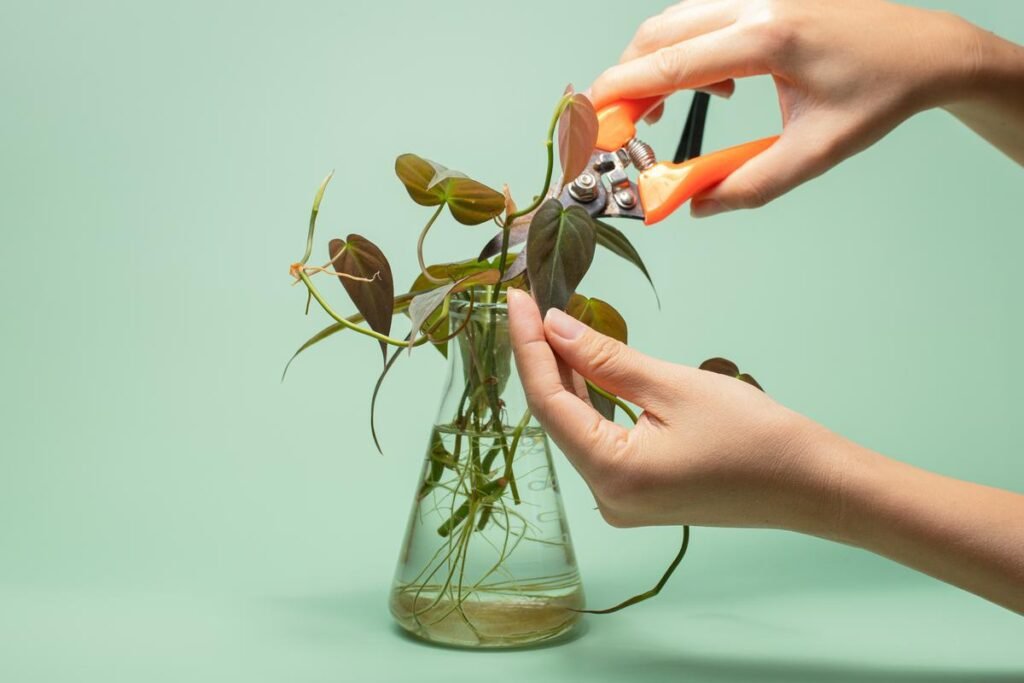
To prune your philodendron micans, use a sharp and sterile pair of scissors or pruning shears and cut off any unwanted or damaged stems or leaves. You can also cut off any long or leggy stems that are taking up too much space or look unappealing. Make sure you cut just above a node (the point where a leaf attaches to the stem), as this will encourage new growth from that point.
How To Propagate Philodendron Micans
Propagating philodendron micans is very easy and rewarding. You can propagate your plant from stem cuttings in water or soil. Here are the steps for both methods:
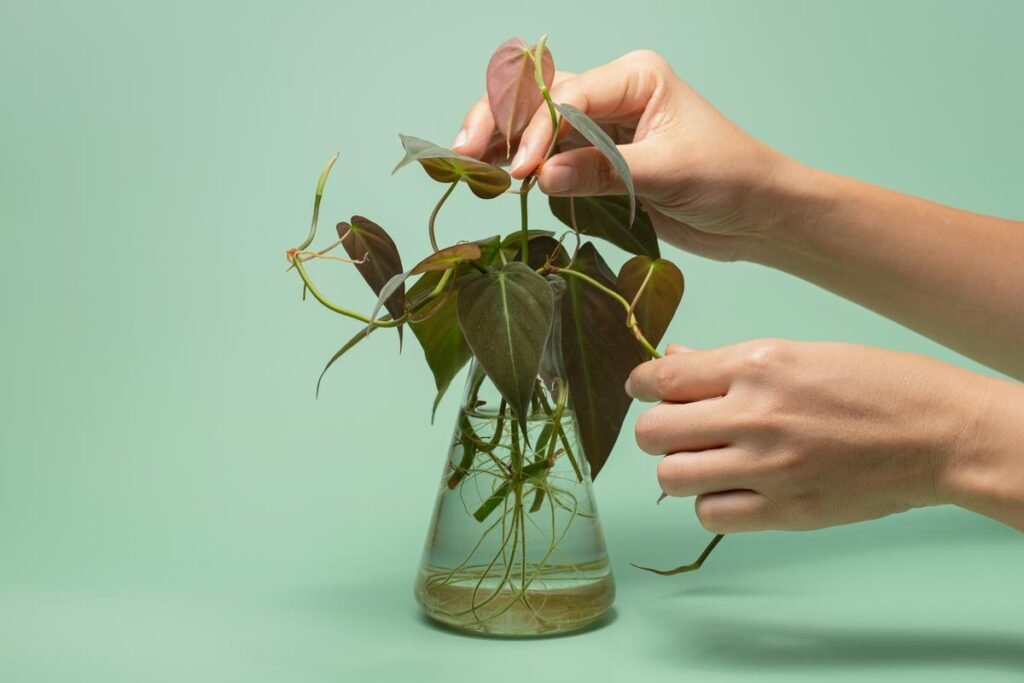
Propagation in Water
- Take a healthy stem cutting from your philodendron micans with at least one node and one leaf.
- Remove any lower leaves from the cutting and trim any aerial roots if present.
- Place the cutting in a jar or vase of clean water, making sure that the node is submerged but the leaf is above the water level.
- Place the jar or vase in a bright spot with indirect light and change the water every few days.
- Wait for roots to develop from the node, which can take anywhere from two weeks to two months.
- Once you see enough roots (at least an inch long), you can transplant your cutting into a pot with fresh potting mix.
Propagation in Potting Soil Mix
- Propagation in Potting Soil Mix
- Take a healthy stem cutting from your philodendron micans with at least one node and one leaf.
- Remove any lower leaves from the cutting and trim any aerial roots if present.
- Dip the cut end of the cutting in some rooting hormone powder or gel, if you have any. This will help speed up the root development and prevent infections.
- Fill a small pot with fresh potting mix and make a hole in the center with your finger or a pencil.
- Insert the cutting into the hole and gently press the soil around it to secure it.
- Water the cutting well and place it in a bright spot with indirect light. You can also cover the pot with a plastic bag or a dome to create a mini greenhouse and increase the humidity.
- Keep the soil moist but not soggy and mist the cutting occasionally. You can also fertilize it with a weak liquid fertilizer once a month.
- Wait for new growth to appear, which can take anywhere from four weeks to four months, depending on the season and the conditions.
- Once you see new leaves, you can remove the plastic cover and transplant your cutting into a bigger pot if needed.
Growth and Care Tips for Velvet Leaf Philodendron
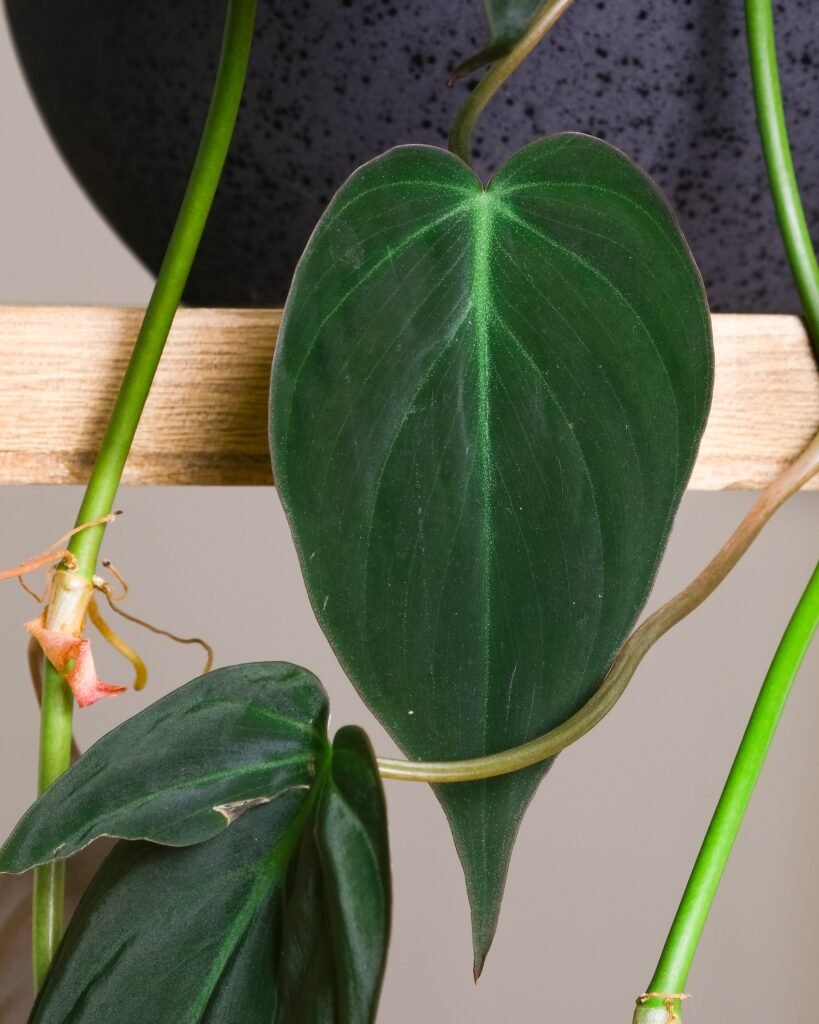
Philodendron micans is also known as velvet leaf philodendron because of its soft and velvety leaves. This feature makes it a very attractive and appealing houseplant, but it also requires some extra care and attention. Here are some growth and care tips for velvet leaf philodendron that will help you keep your plant healthy and beautiful:
- Keep your velvet leaf philodendron away from direct sunlight, as it can damage the delicate leaves and make them lose their velvety texture. Instead, provide your plant with medium to bright indirect light, such as near a window with a sheer curtain or a skylight.
- Avoid touching or rubbing the leaves too much, as this can also affect their texture and appearance. You can gently dust the leaves with a soft brush or cloth if they get dirty, but do not use any harsh chemicals or detergents.
- Provide your velvet leaf philodendron with high humidity levels, as this will help maintain the moisture and softness of the leaves. You can mist your plant regularly with water, place it on a tray of pebbles and water, use a humidifier, or group it with other plants that increase the humidity.
- Do not overwater or underwater your velvet leaf philodendron, as this can cause the leaves to droop or curl. Water your plant only when the top inch of the soil feels dry to the touch, and make sure the excess water drains out of the pot. You can also use a moisture meter or a wooden skewer to check the soil moisture level.
- Fertilize your velvet leaf philodendron once a month during the growing season (spring and summer) with a balanced liquid fertilizer diluted to half strength. Do not fertilize your plant in the winter, as this can cause salt buildup in the soil and burn the roots.
Addressing Common Pests and Diseases
Philodendron micans is generally resistant to most pests and diseases, but it can still be affected by some common problems that affect many houseplants. Here are some of the most common pests and diseases that you might encounter with your philodendron micans, and how to address them:
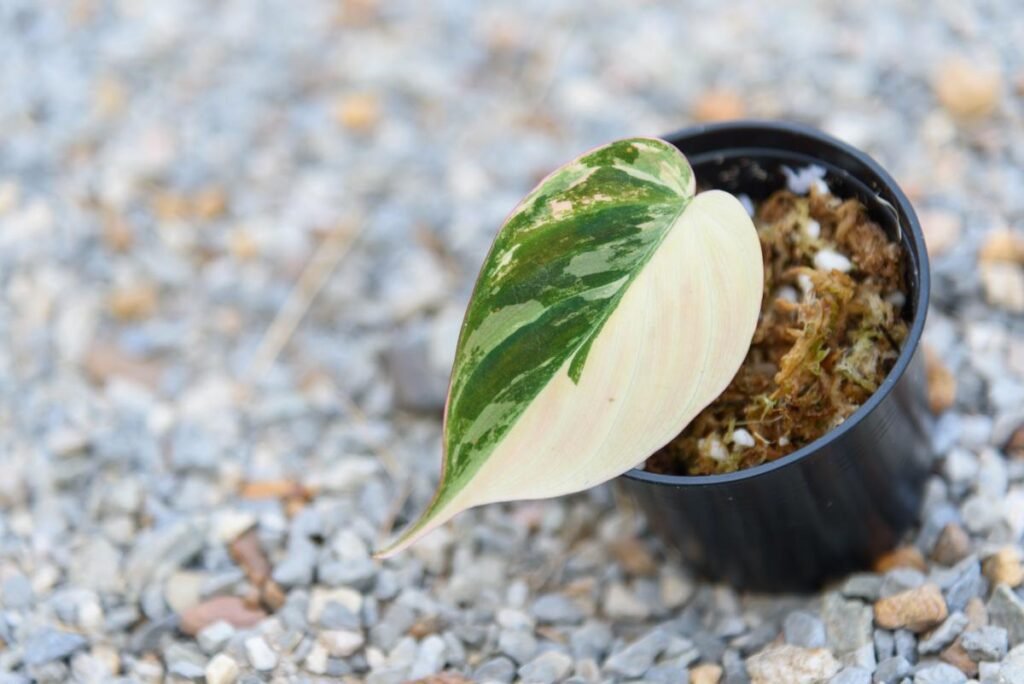
Identification of Common Pests in Philodendron Micans
Some of the common pests that can infest your philodendron micans are:
- Spider mites: These are tiny spider-like creatures that suck the sap from the leaves, causing them to turn yellow, brown, or gray. They also leave behind fine webs on the underside of the leaves or on the stems.
- Mealybugs: These are small white bugs that look like cotton balls. They also suck the sap from the leaves and stems, causing them to wilt or curl. They also secrete a sticky substance called honeydew, which can attract ants or fungus.
- Scale insects: These are small brown or black bugs that attach themselves to the stems or leaves. They also suck the sap from the plant, causing it to weaken or die. They also secrete honeydew, which can cause sooty mold to grow on the plant.
- Aphids: These are small green, yellow, or black bugs that cluster on the new growth or buds of the plant. They also suck the sap from the plant, causing it to deform or stunt. They also secrete honeydew, which can cause fungal infections or attract other pests.
How to Handle Disease Problems
Some of the common diseases that can affect your philodendron micans are:
- Root rot: This is caused by overwatering or poor drainage, which allows fungus to grow in the soil and attack the roots. The symptoms include yellowing or wilting of the leaves, mushy or brown roots, and foul smell from the soil.
- Leaf spot: This is caused by fungal or bacterial infections that create spots or patches on the leaves. The spots can be brown, black, yellow, or gray, depending on the type of infection. The spots can also have a halo around them or have holes in them.
- Powdery mildew: This is caused by fungal spores that land on the leaves and create a white or gray powdery coating on them. The coating can reduce photosynthesis and make the leaves look dull or discolored.
Maintaining a Pest and Disease-Free Philodendron Micans
To prevent pests and diseases from affecting your philodendron micans, you need to follow some simple steps:
- Inspect your plant regularly for any signs of pests or diseases. If you notice any problems, isolate your plant from other plants and treat it as soon as possible.
- Use clean and sharp tools when pruning or propagating your plant. Sterilize them with alcohol or bleach before and after each use.
- Use fresh and well-draining potting mix for your plant. Avoid reusing old soil that might contain pathogens or pests.
- Water your plant properly and avoid overwatering or underwatering. Allow the soil to dry out slightly between waterings and make sure the pot has drainage holes.
- Provide adequate light and air circulation for your plant. Avoid placing it in direct sunlight or in a dark or stuffy area.
- Fertilize your plant moderately and only during the growing season. Avoid overfertilizing or underfertilizing your plant, as this can cause nutrient imbalance or deficiency.
- Use natural or organic methods to control pests and diseases. You can use neem oil, insecticidal soap, or horticultural oil to spray your plant and kill the pests. You can also use baking soda, vinegar, or hydrogen peroxide to treat fungal or bacterial infections. You can also introduce beneficial insects such as ladybugs or lacewings to eat the pests.
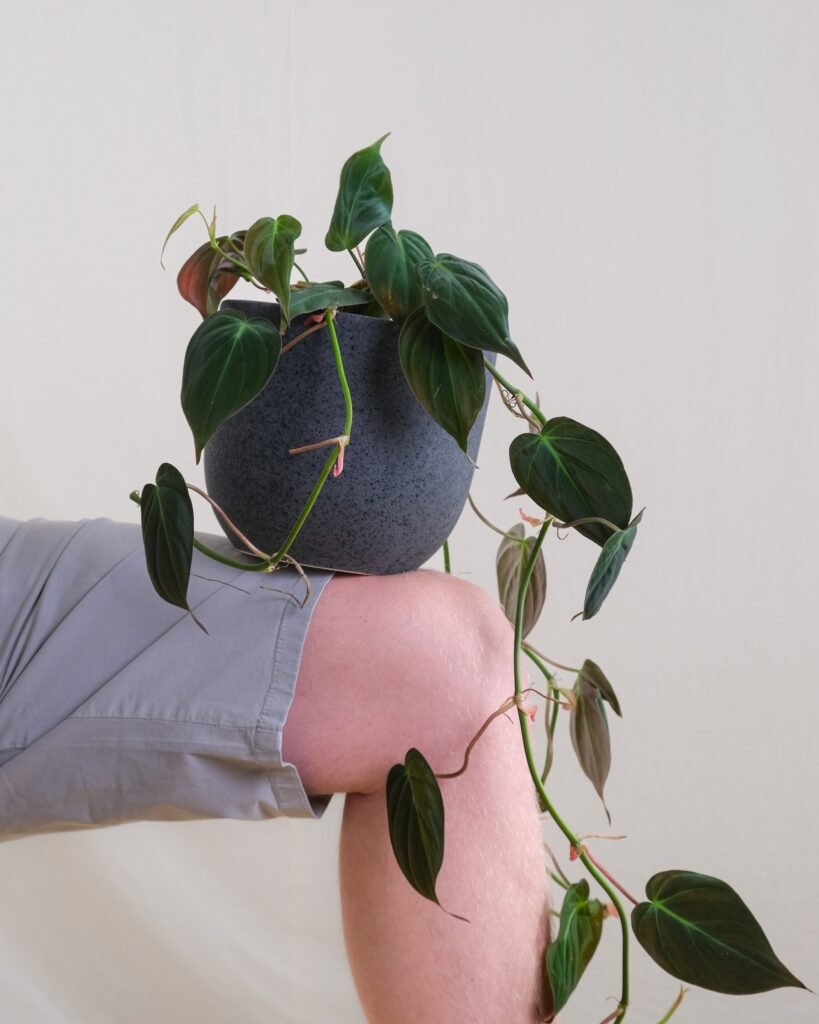
Frequently Asked Questions about Philodendron Micans Care
Why are my Philodendron Micans leaves curling?
There are several reasons why your philodendron micans leaves might be curling, such as:
- Low humidity: If the air is too dry, your plant might curl its leaves to reduce water loss through transpiration. You can increase the humidity around your plant by misting it regularly, placing it on a tray of pebbles and water, using a humidifier, or grouping it with other plants.
- Underwatering: If the soil is too dry, your plant might curl its leaves to conserve water and prevent wilting. You can water your plant more often and check the soil moisture before watering. You can also use a moisture meter or a wooden skewer to test the soil moisture level.
- Overwatering: If the soil is too wet, your plant might curl its leaves to avoid drowning or rotting. You can water your plant less often and make sure the excess water drains out of the pot. You can also improve the drainage of the soil by adding perlite, orchid bark, or peat moss.
- Pests: If your plant is infested by pests such as spider mites, mealybugs, scale insects, or aphids, they might curl their leaves to protect themselves from the sap-sucking insects. You can inspect your plant for any signs of pests and treat them accordingly. You can use natural or organic methods to control pests and diseases.
What to do with mushy stems in Philodendron Micans?
Mushy stems in philodendron micans are usually a sign of root rot, which is caused by overwatering or poor drainage. Root rot is a serious problem that can kill your plant if not treated promptly. Here are some steps you can take to deal with mushy stems in philodendron micans:
- Remove your plant from the pot and inspect the roots. Cut off any mushy or brown roots with a clean and sharp pair of scissors or pruning shears. Sterilize them with alcohol or bleach before and after each use.
- Wash the remaining roots with clean water and let them dry for a few hours.
- Repot your plant in a fresh and well-draining potting mix. Use a pot that is slightly larger than the root ball of your plant, and make sure it has drainage holes at the bottom.
- Water your plant thoroughly but sparingly until it recovers. Do not let your plant sit in water, as this can cause root rot again.
- Place your plant in a bright spot with indirect light and high humidity. Avoid direct sunlight or dark areas.
- Fertilize your plant lightly once a month with a balanced liquid fertilizer diluted to half strength.
How often should I repot my Philodendron Micans?
Philodendron micans does not need to be repotted very often, as it has a small root system and does not grow very fast. You can repot your plant once every two years or when you notice any of these signs:
- The roots are growing out of the drainage holes of the pot.
- The soil is compacted or depleted of nutrients.
- The pot is too small or too heavy for the plant.
- The plant is showing signs of stress or disease.
How fast do Philodendron Micans grow?
The growth rate of Philodendron Micans can vary depending on the care provided, but they are generally considered to be moderate to fast growers. With the right conditions, you can expect them to produce new leaves and vines throughout the growing season, which is typically spring and summer. It’s not uncommon for them to grow a few feet in a year under optimal conditions.
How to root Philodendron Micans?
To root a Philodendron Micans cutting, follow the propagation instructions mentioned above. Choose a healthy stem cutting, allow it to callus, and then either place it in water or well-draining soil. Provide the appropriate care conditions with indirect light, humidity, and consistent moisture to encourage root development. It’s essential to be patient, as rooting can take a few weeks to a couple of months.
Exploring Varieties and Similar Plants to Philodendron Micans
Philodendron micans is one of the many varieties of philodendron plants that you can grow and enjoy indoors. If you like philodendron micans, you might also like some of these similar plants that have similar characteristics or features:
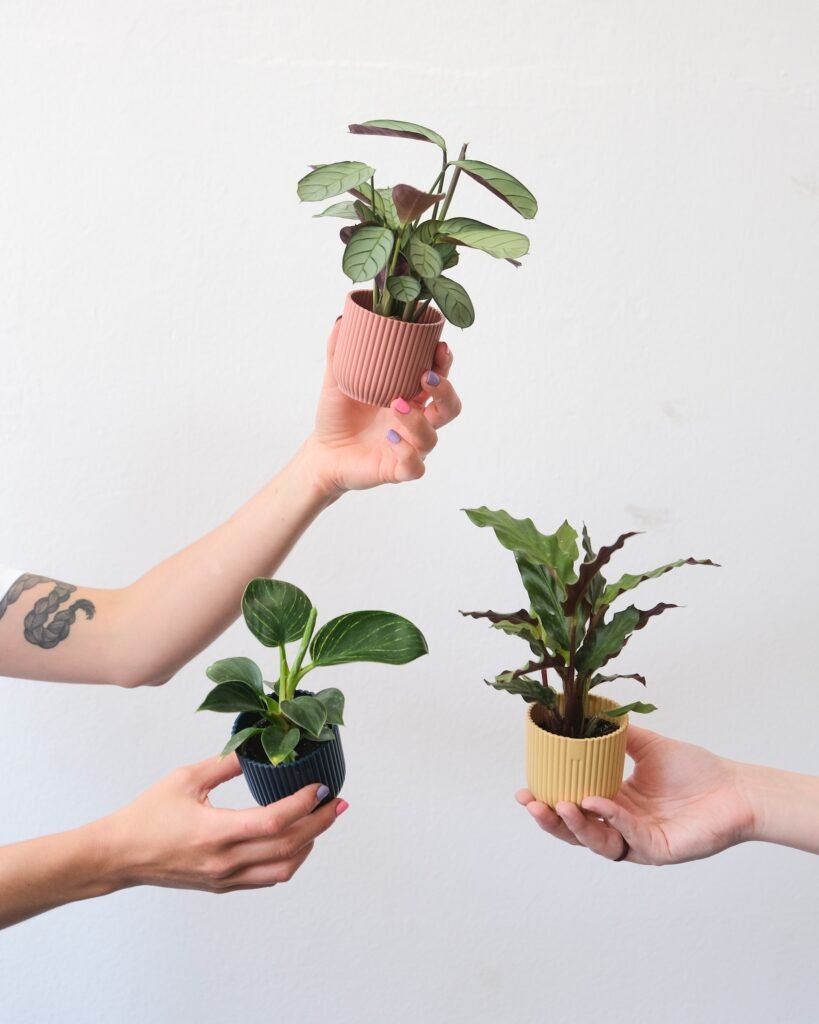
Philodendron Erubescens
Philodendron erubescens, also known as the blushing philodendron or the red-leaf philodendron, is a tropical plant that belongs to the aroid family. It is native to Colombia and the rainforests of South America, where it can grow up to 60 feet in length as a climbing vine. As a houseplant, however, it usually stays around 3 feet long and produces attractive foliage with reddish or pink undersides.
Philodendron Brasil
Philodendron brasil is another variety of heartleaf philodendron that has variegated leaves with green and yellow stripes. It is also a vining plant that can trail or climb, and it has the same care requirements as philodendron micans. Philodendron brasil is a great plant for adding some color and contrast to your home or office.
Philodendron Hastatum
Philodendron hastatum is also known as silver sword philodendron because of its silvery-blue leaves that have a sword-like shape. It is a climbing plant that can grow up to 10 feet tall, and it needs a moss pole or trellis to support its growth. Philodendron hastatum likes bright indirect light and moderate watering, and it can tolerate lower humidity than other philodendrons.
Philodendron Verrucosum
Philodendron verrucosum is also known as red back philodendron because of its red undersides of the leaves. It has large, velvety, dark green leaves that have prominent veins and warts. It is a climbing plant that can grow up to 6 feet tall, and it needs high humidity and warm temperatures to thrive. Philodendron verrucosum likes bright indirect light and regular watering, and it is one of the most stunning and rare philodendrons.
Final Thoughts on Philodendron Micans Care
Philodendron micans is a beautiful and easy-to-care-for houseplant that can add some tropical charm and elegance to your home or office. By following this comprehensive guide on philodendron micans care, you can ensure that your plant will grow healthy and happy for years to come. Here are some key takeaways to remember:
- Provide your philodendron micans with medium to bright indirect light, but avoid direct sunlight.
- Water your philodendron micans only when the top inch of the soil feels dry, and make sure the excess water drains out of the pot.
- Use a well-draining, airy, and rich potting mix for your philodendron micans, and repot it once every two years or when needed.
- Keep your philodendron micans in a warm and humid environment, between 65°F and 75°F (18°C and 24°C) and around 50% humidity or more.
- Fertilize your philodendron micans once a month during the growing season (spring and summer) with a balanced liquid fertilizer diluted to half strength.
- Prune your philodendron micans to shape it and keep it under control, and propagate it from stem cuttings in water or soil.
- Inspect your philodendron micans regularly for any signs of pests or diseases, and treat them promptly with natural or organic methods.
We hope you enjoyed this article on philodendron micans care, and we wish you all the best in growing and caring for your velvet leaf philodendron. If you have any questions or comments, feel free to leave them below. Happy gardening!


